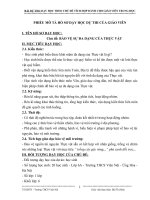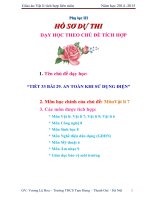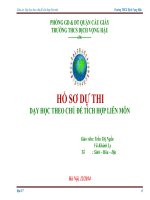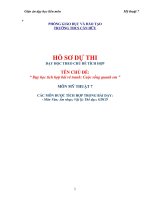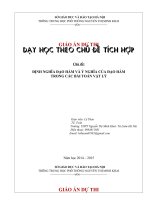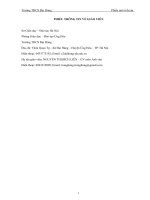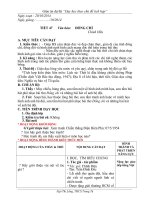GIÁO án dự THI dạy học THEO CHỦ đề TÍCH hợp môn tiếng anh 11 UNIT 10 nature in danger period 63 b speaking
Bạn đang xem bản rút gọn của tài liệu. Xem và tải ngay bản đầy đủ của tài liệu tại đây (295.87 KB, 10 trang )
UNIT 10: nature in danger
Period 63: B - Speaking
I. Objectives
By the end of the lesson, Ss will be able to:
- use the required language to talk about the reasons why nature is threatened
the measures for protecting it with 80% accuracy.
-
understand more about their responsibility in the protection of our
environment.
II. Time: One period of 45 minutes.
III. Students’ level: 11th grade students
IV. Class size: 40 students
V. Teaching aids:
- Textbook, board, chalk, handouts, pictures of endangered nature and posters.
- A computer and a projector to present the lesson using Microsoft office
PowerPoint.
VI. Anticipated problems :
- Ss may not have enough vocabulary and ideas to talk about the topic, so T has to
get ready to help them.
VII. Procedure
Tim
Steps
Work
e
1’
arrangemen
t
Whole class
- Greeting ( teachers and students)
- T checks students’ attendance.
WARM - UP
* Competition game - Network:
4’
- T shows a network of the word “NATURE IN DANGER” on
1
Team work
the projector.
nature in danger
ddanger
- T divides the class into 2 teams (Team A and team B). Each
team has a representative who will go to the board and
complete the network by writing on the board the words
3’
relating to nature in danger that they know.
- The winner will be the team completing the network in the
shortest period of time. (Time limit : 3 minutes)
- T gives suggested answers : water, air, pollutant, extinct,
forest, nature, endanger, animal, … .
* Leading in : - T shows some pictures about nature in danger
and asks some Ss to answer the questions below:
2’
1. What can you see in these pictures ?
2. What problem is this ?
2
Whole class
- T calls on some Ss to give their answers, then give corrective
feedback.
* Suggested answers :
1. We can see : - killing endangered animals
- keeping them as pets
- burning forests
- cutting down trees,
- using fertilizers and pesticides for cultivation and
discharging chemical pollutants into the environment…
2. Our nature is being threatened seriously.
- T leads students to the new lesson : “To know more about
reasons why nature is threatened and mesures to protect it,
let’s learn the new lesson.”:
UNIT 10: NATURE IN DANGER
Period 63: B – SPEAKING
Talking about the reasons why nature is threaten and
suggesting measures to protect the environment
10’
I. TASK 1:
* Aim : to focus Ss on the topic and introduce the new words
and phrases to talk about the reasons why nature is threatened.
* Activity 1: Teaching vocabulary
- T shows on the screen the vocabulary to teach :
1. capture /kæptʃə/ (v):
giam giữ
3
Whole class
2. recreation /rɛkrɪ’eɪʃ(ə)n/ (n) : sự giải trí, sự tiêu khiển
3. fertilizer /fə:tɪlaɪzə/ (n):
phân bón
4. pesticide /’pɛstɪsaɪd/ (n):
thuốc trừ sâu
5. cultivation /kʌlti’veiʃn/(n):
sự trồng trọt
6. discharge /’dɪstʃɑ:dʒ/ (v):
đổ ra, phóng ra
- T helps Ss to pronounce the words correctly. T reads them
first, then asks them to repeat after in chorus and individually.
- T calls on 2 Ss to make sentences with some of these words.
Eg: You shouldn’t use too much pesticides for cultivation.
* Activity 2:
- T asks Ss to work individually to answer the question:
“Which reason you think is the most important ?”.
Individual
work
- T calls on some students to answer.
* Activity 3:
- T prepares handouts No1 in which T provides some ideas for
their explanation for the reasons why nature is threatened, then
delivers them to the Ss.
- T asks Ss to work in pairs to ask and answer about the most
important reason why nature is threatened.
- T shows on the screen this model below for Ss to follow :
Lan: What is the most important reason why nature is
threatened?
Nam: In my opinion/ I think/ I feel burning forests is the most
important reason why nature is threatened.
Lan: Well, why do you think so?
Nam: Oh, forests are green lungs of the Earth where many
animals live. Burning forests means many plants and animals
will die.
Lan : I strongly agree. Moreover, smoke from forest fires
4
Pair work
causes air pollution.
- T goes around to help Ss express their ideas correctly, then
calls on some pairs to practise speaking in front of the class.
8’
- T gives feedback and marks afterward.
II. TASK 2:
* Aim : Ss can match the reasons in Task 1 with possible
measures for protecting the environment.
* Activity 1: Teaching vocabulary
- T shows on the screen the vocabulary to teach :
1. ban (v) = prohibit (v) /prə(ʊ)hɪbɪt/ : cấm
Whole class
2. encourage (v) /ɪnkʌrɪdʒ/ : khuyến khích
> < discourage (v)/dɪskʌrɪdʒ/ : ngăn cản
E.g.: Planting forests should be encouraged.
3. establish (v) /ɪ’stæblɪʃ/ = set up (v.phr) : thành lập
E.g.: Many organizations have been established to protect rare
animals.
- T helps Ss to pronounce the words correctly. T reads them
first, then asks them to repeat after in chorus and individually.
* Activity 2: Matching
- T asks Ss to work in pairs to match the reasons in Task 1 with
possible measures for protecting the environment.
Problems
Solutions
1. Burning forests
A. Killing endangered
2. Cutting down trees for
animals for fur, skin and food
cultivation
should be banned.
3. Discharging chemical
B. Planting trees should be
pollutants into environment
encouraged.
4. Using fertilizers and
C. Keeping animals as pets
5
Pair work
pesticides for cultivation
should be discouraged.
5. Killing endangered
D. Zoos and national parks
animals for fur, skin and
should be established to save
food
animals and plants.
6. Hunting and capturing
E. Animals should not be
animals for recreation
captured for recreation and
7. Keeping animals as pets
entertainment.
F. All kinds of animals and
plants should be protected
G. Discharging chemical
pollutants into the
environment should be
prohibited.
H. Decreasing the use of
fertilizers and pesticides for
farming should be
encouraged.
- T calls on some pairs to read aloud their results, then gives
corrective feedback afterward.
14’
* Suggested answers:
1. B
2. D / F
3. G
4. H 5.A
6.E
7.C
III. TASK 3:
* Aim : Ss state negative impacts made by people on the Whole class
environment and suggest measures to protect it.
* Activity 1:
Useful languages
+ T gives Ss some useful languages for them to expresss their
ideas.
- should + V/ should be + p.p
- should not +V/ should not be+ p.p
- be extinct/ disappear
6
- not hunt or sell animal products
- ban/ prohibit / be banned / be prohibited
Group work
- protect / be protected
- punish / be punished ……..
* Activity 2:
- T prepares handouts No2 in which T provides Ss some
suggestions ideas.
Threats
Consequences
Solutions
1. Burning forests
- Burning forests
- Strictly punish the
cutting down trees
means many
cutting of trees and
for wood
animals may die.
burning forests.
- Smoke from
- Encourage the
forest fire may
planting of forests
pollute the air.
and trees.
- Without trees
the climate will
change for
worse.
2. Using fertilizers - destroy soil,
- encourage the use
and pesticides for
pollute the air
of manure
cultivation
and affect other
- decrease the use of
living species as
fertilizers and
well.
pesticides in
farming
3. Discharging
Dangerous
- … should be
chemical
chemicals can
prohibited
pollutants into the
harm people’s
- … should be fined
environment
lives and cause
7
fatal diseases
such as cancer,
…
4. Killing
Making some
-…should be
endangered
species disappear banned.
animals for fur,
would create a
-…should be
skin and food.
lack of
discouraged
Keeping animals
ecological
Group work
as pets. Hunting or balance.
capturing them for
recreation or
entertainment.
- T divides the class into 8 groups. Each group will receive one
of the 4 handouts. Then, T asks Ss to work in groups to report
negative impacts made by people on the environment and
suggest measures to protect it.
- T asks Ss to work in groups to practise speaking as the
model.
- T shows on the screen a model for Ss to imitate.
Model
Peter: People are killing endangered animals for fur, skin and
food.
Mary: Killing endangered animals for fur, skin and food
should be banned.
Peter: Well, it is violating animals’ rights, too. The best place
for wild animals is natural environments.
John: You are right! We should protect them and tell other
people not to kill them.
8
- T goes around to give help if necessary.
- After some minutes, Ss calls on some groups to perform in
front of the class.
- T gives corrective feedback and marks afterward.
2’
IV. CONSOLIDATION
- T give some pictures about pollution of the environment and Whole class
the nature in danger and ask Ss to find solutions.
- T calls on a Ss to answer.
* Suggested answers:
Pictures about the heavily polluted environment and
nature in danger urge us to take action to protect the nature,
the environment and the Earth.
1’
V. HOMEWORK : T asks Ss to :
- Learn by heart the new words.
- Write a paragraph about measures to protect our natural
environment.
-
Prepare for the next lesson: Unit 10- C. Listening.
----------------------------------------------------------
9
Whole class
10


